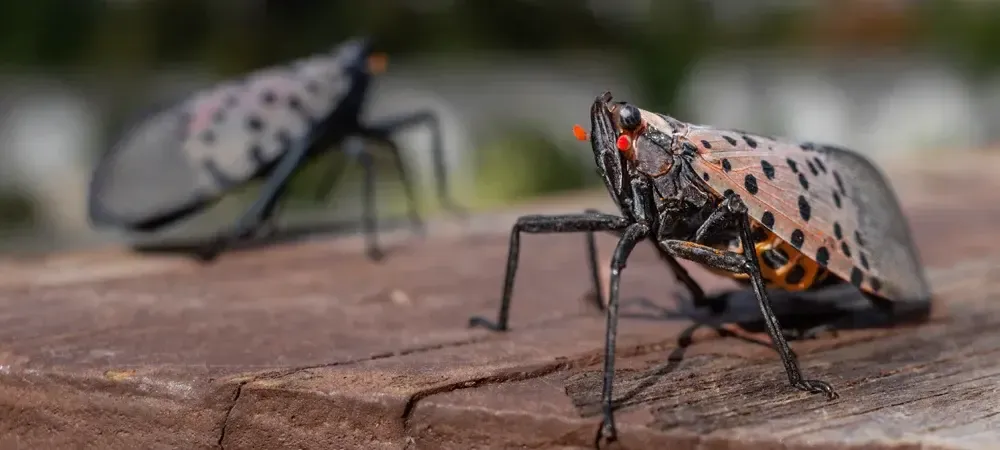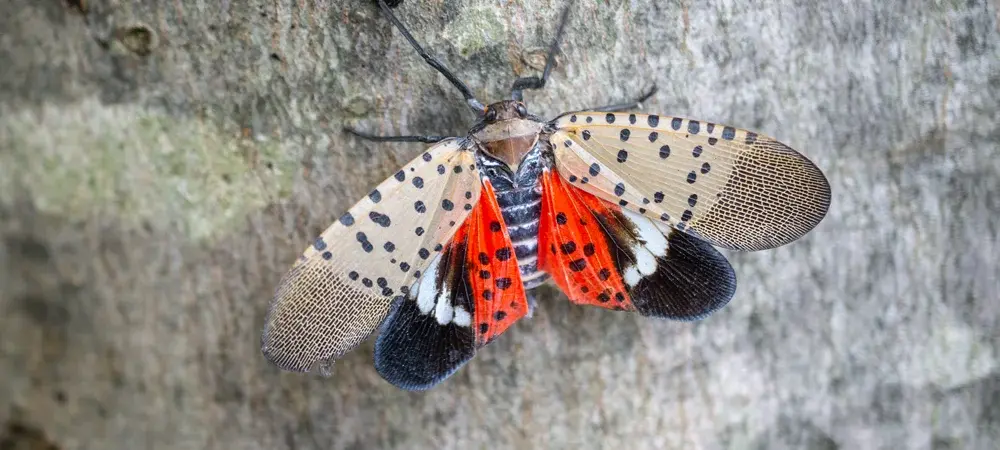What To Know About The Spotted Lanternfly Invasion in North Carolina

As homeowners in North Carolina, we take pride in our vibrant landscapes, from the lush greenery of the Blue Ridge Mountains to the rich agricultural fields of the Piedmont. However, the beauty of our state is currently threatened by an invasive pest: the spotted lanternfly (Lycorma delicatula). This blog will provide essential information about this pest, its impact on our local ecosystems, and practical steps you can take to protect your home and property.
What is the Spotted Lanternfly?
Originally from Asia, the spotted lanternfly was first detected in the United States in Pennsylvania in 2014. It has since spread to several states, including North Carolina. This pest is known for its striking appearance, featuring a yellow body with black spots and vibrant red underwings. While it may look beautiful, its feeding habits can cause significant harm to trees and plants.
How to Identify Spotted Lantern Flies
Spotted lanternflies are distinctive and can be identified by their unique physical features. Here’s what to look for:
- Appearance: Adult spotted lanternflies are approximately 1 inch long and 0.5 inches wide. They have light gray forewings adorned with black spots, featuring wing tips that have patterns of small black blocks. Their hindwings are strikingly red and black with a distinctive white band. The body of the adult is yellow with black bands running down the middle.
- Nymphs: The immature stages, known as nymphs, appear as black with white spots when they first hatch. As they grow, they transition to a red color with black spots before maturing into adults.
- Egg Masses: During the fall, spotted lanternflies lay eggs in masses covered with a gray, putty-like substance, making them look like a smudge. These egg masses are often found on smooth surfaces like tree trunks, outdoor furniture, and stones. Each mass can contain up to 50 eggs, making them a significant concern. Be vigilant during late fall and early spring when they hatch.
What Makes Spotted Lantern Flies Dangerous?
While spotted lanternflies do not bite or sting, they are considered dangerous for several reasons:
- Damage to Plants: spotted lantern flies feed on the sap of various plants, particularly favoring the Tree of Heaven (Ailanthus altissima), maples, willows, apples, and peach trees. Their feeding can weaken trees and plants, making them more susceptible to diseases and other pests.
- Impact on Agriculture: The presence of SLFs can affect local agriculture, leading to potential economic losses for farmers and businesses that rely on crops. In North Carolina, where agriculture and forestry are vital to the economy, the lanternfly poses a serious threat to crops and timber.
- Sooty Mold Growth: As they feed, Lantern Flies excrete a sticky substance known as honeydew, which can attract other pests and lead to the growth of sooty mold. This mold covers the leaves of plants, inhibiting photosynthesis and harming plant health.
- Rapid Reproduction: Spotted lantern flies can reproduce quickly, with females laying up to 50 eggs at a time. This rapid reproduction can lead to large infestations that are difficult to control.
- Adaptability: They have a wide host range, allowing them to thrive in various environments, which contributes to their invasive status.
- Ecosystem Balance: By damaging native plants and trees, SLFs can disrupt local ecosystems, affecting wildlife that depends on these plants for food and habitat.
While spotted lanternflies do not pose a direct threat to humans or pets, their impact on plant health, agriculture, and local economies makes them a significant concern for homeowners and agricultural producers alike. Effective management and prevention strategies are essential to mitigate their dangers.

What Homeowners in North Carolina Can Do
Prevention is key in managing spotted lanternflies. Here are some effective strategies for homeowners in North Carolina:
- Inspect Your Property: Regularly check your trees and plants for spotted lanternflies, particularly during late spring and early summer when they are most active. Look for egg masses on tree trunks, sidewalks, and outdoor furniture.
- Report Sightings: If you spot a lanternfly or its egg masses, report it to the North Carolina Department of Agriculture and Consumer Services (NCDA&CS) or your local county extension office. Your reports can help track the pest's spread and inform control efforts.
- Manage Infestations: If you find a significant number of lanternflies on your property, consider contacting a local pest control professional. They can provide treatments tailored to your situation and ensure that the problem is managed effectively.
- Educate Your Community: Spread the word about the spotted lanternfly among your neighbors. The more people are aware of this invasive pest, the better we can protect our local ecosystems.
How to Get Rid of Spotted Lantern Flies
Getting rid of spotted lanternflies effectively requires a combination of strategies to manage their population and minimize damage to plants. Here are some effective methods to control and eliminate these pests:
1. Physical Removal
If you spot an adult or nymph, you can squash it using your shoe or a hard object. This is one of the simplest methods for small infestations. Alternatively, you can use a vacuum to suck up nymphs and adults. Make sure to dispose of the vacuum bag or contents in a sealed plastic bag to prevent them from escaping.
2. Use Sticky Traps
Place sticky traps around the base of trees and in areas where you notice spotted lanternflies. These traps can capture nymphs and adults as they move up and down the tree. Check traps regularly and replace them as needed. Make sure the traps are high enough to avoid catching non-target species but low enough to be effective.
3. Select Appropriate Insecticides
Consult with a local pest control expert or your county extension office to identify effective insecticides. Products containing active ingredients like imidacloprid, dinotefuran, or bifenthrin can be effective against SLFs. Always adhere to the manufacturer’s instructions for safe application, and take care to protect beneficial insects and pollinators.
4. Remove Host Plants
If you have any tree of heaven (Ailanthus altissima) on your property, as it is a preferred host for the lanternfly. This can help reduce the local population and protect other plants. You should also regularly clean up debris in your yard and around outdoor structures. This includes removing any potential egg masses you find on smooth surfaces.
5. Monitoring and Reporting
Regularly inspect your property for spotted lantern flies, especially during spring and fall when they are most active. If you see spotted lanternflies, report them to your local agricultural department. This information helps track their spread and implement control measures.
6. Hire Pest Control Services
For severe infestations or if you're unsure how to manage spotted lantern flies effectively, consider hiring a licensed pest control service. Our team of professionals at Triangle Pest Control can assess the situation and apply treatments safely and efficiently.
How To Report Spotted Lantern Flies In NC
If you spot spotted lanternflies (SLFs) in North Carolina, it's essential to report them to help control their spread and protect local ecosystems and agriculture. Here’s how you can report SLFs in the state:
North Carolina Department of Agriculture and Consumer Services (NCDA&CS)
- Online Reporting: You can report sightings directly through the NCDA&CS website. They have a dedicated page for reporting invasive species, including spotted lanternflies.
- Contact Information: If you prefer to report via phone or have questions, you can contact the NCDA&CS Plant Industry Division:
- Phone: 1-800-206-9333 (toll-free)
- Email: plant.protection@ncagr.gov
University Extension Offices
- Local Assistance: Your local county extension office can also help with reporting and providing information about spotted lanternflies. They can guide you on management strategies and the reporting process.
- To find your local extension office, visit North Carolina Cooperative Extension.
Community Engagement
- Neighborhood Groups: Join local gardening clubs or community forums where members may share sightings and information about invasive pests, including spotted lanternflies.
- Social Media: Use community groups on platforms like Facebook or Nextdoor to report sightings and raise awareness among your neighbors.
- Spread the Word: Educate friends, family, and neighbors about the importance of reporting SLFs and how to identify them. The more people are aware, the better the chances of controlling their spread.
What to Include When Reporting
When reporting spotted lanternflies, provide as much information as possible, including:
- Location: Exact location where you spotted them (address, GPS coordinates if possible).
- Description: Include details about what you observed (adults, nymphs, egg masses).
- Date: The date you saw the SLFs.
- Photographs: If possible, take clear photos of the insects and any egg masses to aid in identification.
Considerations
As a homeowner in North Carolina, staying informed about the spotted lanternfly invasion is crucial. By learning how to identify these pests, understanding their potential dangers, and managing them, you can help protect your home, landscape, and local ecosystems from this invasive threat.
Stay vigilant and proactive—your actions can make a significant difference in controlling the spread of spotted lanternflies in our beautiful state! If you have any questions or need assistance, feel free to reach out to your local experts at Triangle Pest Control for guidance.



